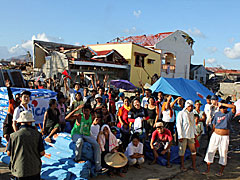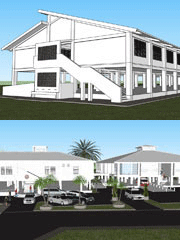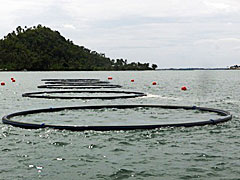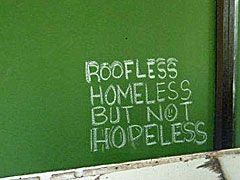[Japan International Cooperation Agency] [Wednesday, Nov 19, 2014]
Toward a New Normal: One Year after Typhoon Yolanda
A year has now passed since Typhoon Yolanda hit the Philippines on November 8, 2013, a year during which the lives of so many people in the country changed. One of a number of international organizations and donors providing assistance—both public or private—JICA has been using the experiences and skills gained from disaster response efforts in Japan to provide assistance with the motto of “Build Back Better.”
Emergency assistance in the aftermath of disaster
In addition to providing emergency supplies, JICA dispatched in succession a total of five Japan Disaster Relief teams, namely, three medical teams, an expert team to evaluate the damage and needs on the ground, and another expert team to provide advice on an oil-spill disaster (1). Although JICA has more than three decades of experience in providing emergency relief, sending out five teams in less than two months was a first for JICA that required an enhanced level of response.
Amid conflicting reports and difficulties in ensuring supplies were delivered locally, the most important issues were security and securing distribution route. In times of emergency, JICA typically hands over emergency supplies to the national government at the airport or seaport; however, the capacity of the Government of the Philippines and especially of local governmental offices was compromised by the catastrophe, making it highly likely that the supplies will not be delivered to those in need.
Given the situation, then Chief Representative Takahiro Sasaki of the JICA Philippine Office led the staff in directly delivering the supplies to Ormoc and Palo on Leyte, to Guian on Samar and many other locations, using ferries and trucks in collaboration with Japanese companies. The Japan Self-Defense Forces, the Philippine National Police and the Philippine Army provided logistics support to ensure the deliveries were made.
From emergency assistance to restoration and reconstruction
While these emergency supplies were being delivered and the medical teams were in operation, an expert team for evaluating the damage and needs was swiftly assembled and deployed on the ground to assess the situation. Based on that assessment, JICA coordinated with the Philippines to focus on 18 local government units (LGUs) that were damaged by storm surges on the coastal areas of Leyte and Samar.
It was determined that these 18 administrative LGUs were areas where JICA could best apply its experiences in the aftermath of the tsunamis from the 2011 Great East Japan Earthquake and damage caused by storm surges when Typhoon Vera struck Ise Bay, Japan, about 50 years ago. Working tirelessly through the Christmas holiday, JICA personnel maintained their emergency assistance, and JICA soon pivoted its focus toward recovery and reconstruction.
In February 2014, a delegation from Higashi-Matsushima, one of the communities that suffered greatly from the Great East Japan Earthquake, visited some of the affected areas in the Philippines to share their experiences with the Philippine government, both central and local, found that the local reconstruction plan that the delegation brought was an excellent reference for concrete measures to implement in rebuilding, and in particular, a land use map in the plan was useful as it depicted a no-build zone, a concept they were not familiar with.
Although there is a wide difference in the budgetary capacities of Japan and the Philippines, one of the delegation members who led the reconstruction efforts at Higashi-Matsushima provided some advice that gave a useful perspective on the situation. He said, “What is important is that community participate in the planning and implementation process,” wisdom that the Philippine government took to heart.
At the end of March, a new ODA loan agreement for a Post Disaster Stand-by Loan was signed between Japan and the Philippines which established a framework for promptly responding to the financial requirements when a state of national calamity is declared in the Philippines, and accelerated the recovery and reconstruction efforts by the Government of Philippines.
Reconstruction assistance to a ‘new normal’
---Supporting disaster-proof structures with ‘program grant aid’---
Reconstruction toward a new normal is not merely making repairs or retrieving what was lost but is about supporting efforts to build a new community. Reconstruction support is centered on program grant aid and urgent development study.
The program grant aid of 4.6 billion yen supports construction of schools, medical facilities, and local government offices, as well as procuring equipment for airport, maritime polytechnic center, electricity associations, meteorological radar facilities, local offices of the Department of Public Works and Highways (DPWH) and fisheries center. The Build Back Better concept is introduced in all projects to aim for disaster-resilient structures.
For example, these buildings were located in a wide area covering multiple communities in targeted areas of said assistance. By constructing resilient buildings, they can function as local emergency center hubs. For buildings close to the seashore, the piloti style (2) of architecture will be applied in which the second floor is utilized as an evacuation center when a disaster occurs, and the first floor serves as an athletic field with shade from the hot sun and a meeting hall for everyday use. Each municipal building will have a multipurpose hall in the center that can also be used as an evacuation site in emergency.
---Providing a blueprint for reconstruction with ‘urgent development study’---
Urgent development study is currently ongoing, and the primary activities these surveys are being used for are to support recovery and reconstruction planning, and to implement quick impact projects (QUIPs).
Such study assessed damage scientifically and produced a hazard map to aid the Government of Philippines—which is largely tied up in making emergency recovery plans and managing projects—in drafting a mid- to long-term plan. In addition, they jointly draft a blueprint for reconstruction that includes a land use plan based on said hazard map and incorporated disaster-resilient development.
This month, a year after the disaster, JICA plans to formally hand over the hazard map to the Government of Philippines and explain how to use the map to the relevant governmental agencies and affected local governments. JICA will continue to provide support through dialog with the local governments so that they will not “Build Back Worse” by putting too much stress on the speed of reconstruction.
---Facilitating reconstruction with QUIPs---
As the name indicates, a QUIP is a project to support the recovery of economic activity and livelihoods as well as strengthening the disaster preparedness and response of LGUs in the targeted region to expedite the reconstruction process. In such regions as Basey on Samar and Tanauan on Leyte, 15 QUIPs have been implemented for various purposes, including re-establishing aquaculture and rebuilding schools to train local government engineers and workers on ground.
So as not to limit the scope of the assistance, when planning each project, JICA bears in mind that the lessons and technologies learned from reconstruction works in Japan are utilized to this recovery and reconstruction support, and gives priority to revive livelihood and community. More specifically, QUIP 1) utilizes the lessons learned at Higashi-Matsushima, 2) builds capacity and skills in repair work by dispatching Japanese and Japan-resident Filipino carpenters, and 3) revives the livelihood of fishermen by introducing submersible fish farming cages developed with technology of a Japanese company.
The innovative submersible fish farming system being installed in Samar Bay has attracted a great deal of attention, and a handover ceremony is planned to be held shortly. Typhoon Yolanda swept away all of the 110 preserves in the area but the new submersible fish farming system will be able to avoid damage as the cages sink during storms.
To add extra value to the cultivated fish, a facility for de-boning milk fish has been set up. The facility will employ women, expanding the job opportunities for them. The de-boned milk fish from the Samar Bay is expected to become a specialty of the Philippines in the near future and is expected to be a good example of the Build Back Better concept.
A major problem on the ground is lack of human resources for construction and related work. While the reconstruction work is fully underway, a serious shortage remains of construction specialists such as engineers, site supervisors and carpenters who are capable of material procurement, designing, building and finishing along the lines of the Build Back Better policy.
A factor that makes it difficult to implement the Build Back Better policy is that buildings originally existed were in any way not resilient and there is a lack of proper materials.
Before Typhoon Yolanda hit the country, JICA had provided cooperation to the DPWH for drafting design standards for quake resilient buildings. In connection with that cooperation, JICA has continued discussions with the Secretary of the DPWH immediately after the disaster and supported the improved design of new schools incorporating Japanese technology and expertise so they are strong enough to resist a storm surge and strong winds. JICA also created an easy-to-understand handbook designed for local engineers, and shared it with the DPWH, the Department of Education, development partners and non-governmental organizations.
QUIPs utilize building restoration sites as an opportunity for on-the-job training, in partnership with the Technical Education and Skills Development Authority (TESDA). QUIPs also provide capacity building for engineers as well as TESDA graduates as carpenters at local governments through joint efforts to repair marketplaces and other such buildings.
Roofless and homeless but not hopeless
Officers from the JICA Philippine Office make a visit to the affected areas on an almost monthly basis. Merely a month or two after the disaster, trees denuded by the winds and toppled coconut trees were scattered everywhere, and bald mountains testified to the magnitude of the disaster. Roads were blocked with debris and shops remained shuttered. The night was pitch black due to a power outage and a feeling of insecurity prevailed, discouraging people from walking about.
Today, the roads have been cleared, and new foliage has sprung up with deep shades of green. The owners of sari-sari stores (3) and restaurants have returned and reopened the doors. Though many people remain displaced and still live in tents, children can now be seen outside, playing and laughing.
“We are roofless, we are homeless, but we are not hopeless.” This sign of hope found on a chalkboard (see photo above) represents the spirit found at disaster sites right after the typhoon had passed. This spirit will help sustain the affected people during their reconstruction, and JICA will continue to provide assistance for them.
Notes:
1: To respond to an accident of oil-spill after a power plant barge was run ashore by the typhoon, JICA, in partnership with the Japan Coast Guard, dispatched a team to conduct an investigation as well as advise the Government of the Philippines on oil removal.
2: An architectural style of two or more stories with supporting columns on the ground level.
3: A small convenience store operated in the doorway of a house that carries groceries, beverages and other commodities.
 Relief spreads through a village after receiving emergency supplies in the aftermath of the disaster inTanauan on the island of Leyte.
Relief spreads through a village after receiving emergency supplies in the aftermath of the disaster inTanauan on the island of Leyte.  An architect’s rendition of a completed elementary school designed in the piloti style, above, and a completed local government office andrural health unit also in the piloti style, below.
An architect’s rendition of a completed elementary school designed in the piloti style, above, and a completed local government office andrural health unit also in the piloti style, below.  A submersible fish cage is being installed in Basey on Samar.
A submersible fish cage is being installed in Basey on Samar.  A message of hope was found on a chalkboard immediately after the typhoon passed.
A message of hope was found on a chalkboard immediately after the typhoon passed.
[Cabinet Secretariat] [Tuesday, Nov 18, 2014]
Press Conference by Prime Minister Abe
Opening statement by Prime Minister Shinzo Abe
PRIME MINISTER ABE: Since April, the Japanese people have been shouldering a consumption tax rate of 8 per cent. Ever since I took the decision to raise the tax rate by 3 percentage points, from 5 per cent to 8 per cent, I have been considering all the while whether or not we should carry out a further increase to 10 per cent in October 2015, as scheduled. A raise in the consumption tax rate is necessary in order for Japan to pass down to the next generation a social security system that is one of the best in the world and in order to enhance our support for child-rearing. It is precisely for these reasons that during the days of the government led by the DPJ, we the LDP supported the bills to reform the tax system, even as an opposition party. However, if raising the consumption tax causes the economy to falter, it will impart a major strain upon people’s daily lives. And if, as a result, tax revenues do not increase despite raising the tax rate, then no benefits will derive from it. The economy is a living thing.
Yesterday, the preliminary quarterly estimates of GDP were released for July, August, and September. Regrettably, the economy has not returned to a growth track. I listened to the views of more than 40 eminent persons regarding whether or not to raise the consumption tax rate. I also sought out the views of the members of my economic policy “brain trust,” holding numerous discussions over time. Taking all of that into comprehensive consideration, today I reached the conclusion that it is better to postpone raising the consumption tax rate to 10 per cent by 18 months rather than increase it in October 2015 as set forth in the relevant laws, in order to ensure that Abenomics succeeds in getting rid of deflation and making the economy grow.
However, what I would like to say to all of you on this occasion is that the “three arrows” of my economic policy are most certainly poised to bring positive results. Within economic policy, the most important indicators in any country are employment and wages. Since the inauguration of this government, employment has increased by more than 1 million people. The ratio of job offers to job seekers is now at its highest level in 22 years. This spring, salaries increased by more than 2 per cent on average. This is the highest rate of increase during the past 15 years. An economic virtuous circle is truly just beginning to take shape, in which corporate earnings increase, employment expands, wages rise, and consumption grows, leading to an economic recovery.
Therefore, I have kept my eyes fixed on trends in personal consumption more than anything else. According to the preliminary GDP estimates for July through September released yesterday, personal consumption has decreased by more than 2 per cent year-on-year, continuing the trend of the April through June period. At present, the 3 percentage point increase in the consumption tax rate is a significant weight tamping down personal consumption. I have come to the conclusion that raising the consumption tax rate by 2 per cent from next October, following upon the 3 per cent increase this past April, will further depress personal consumption and jeopardize Japan breaking free from deflation.
Since September, we have once again convened the meeting of the government, management, and labor. We held this meeting for the first time last year. As the government vigorously put the Growth Strategy into practice, business circles also took the step of raising wages. We will carry out the Growth Strategy even more intensely than before by reviving manufacturing and revitalizing small- and medium-sized enterprises and by creating environments in which women find it easy to work. Through this, we will create a situation in which income will rise steadily next spring, then again the following spring, and yet again the spring after that. By reliably boosting the income of the public overall, we will make the effects of economic recovery carry over amply into the economies of our local regions as well. I believe that by doing so, we will be able to prepare the environment for raising the consumption tax rate.
For this reason as well, we will boost consumption by individuals and carry out robust economic countermeasures that raise the level of the local economies. We will submit the necessary supplementary budget to the next ordinary Diet.
I will now address fiscal reconstruction. The laws on the comprehensive reform of social security and taxation systems provide for a decision to be made on whether or not to raise the consumption tax rate in light of the economic situation. Based on these provisions for making a decision on the state of the economy, I have decided at this juncture to postpone the increase.
However, that does not mean that we are lowering the flag of fiscal reconstruction. We must ensure trust in Japan within the international community. In addition, we will carry out our duty to hand down the social security system to the next generation. This position of the Abe Cabinet will never waver.
There are some who say that we will postpone the October 2015 increase by 18 months and then once those 18 months have passed, we will postpone it yet again. Here, I declare unambiguously to you that there will be no further postponements. The April 2017 increase will be carried out without fail, without any provisos for decisions based on the economic climate. I am determined that, by advancing the “three arrows” more over the next three years, we will most certainly be able to create those economic conditions.
We will resolutely stay the course towards our goal for fiscal soundness to be achieved by fiscal 2020. By the summer of 2015, we will draw up concrete plans for achieving this goal.
We will simultaneously bring about the dual goals of economic revival and fiscal reconstruction. The decision that will make this possible is the one that I took today.
In order to bring into realization all that I have just conveyed to you, as we work to formulate the budget for fiscal 2015, we will also advance our preparation of relevant bills and submit them to next year’s ordinary Diet.
In this way, now that I have taken this decision that is very weighty in terms of both people’s daily lives and the national economy, I have determined that it is imperative to seek a popular mandate promptly. I will dissolve the House of Representatives this week on the 21st. I wish to ask for the decision of the public regarding the point that we should postpone the raising of the consumption tax rate by 18 months and raise it to 10 per cent without fail in April 2017, and also regarding whether or not the economic policies and Growth Strategy we have been pursuing should be advanced further.
I will explain why I will dissolve the House of Representatives this week. It is because in asking for the public’s judgment, I considered this week to be the last possible timing for not causing a delay in preparing the budget for fiscal 2015.
Currently in the House of Representatives, we, the ruling coalition of the LDP and New Komeito, hold a large number of seats. This is something for which I am grateful. I am aware that some voices are saying, ‘what are you thinking—if you hold an election, you will surely end up with fewer seats.’ I am fully aware that the election campaign will be an intense one.
However, the tax system is very closely connected with people’s daily lives. ‘No taxation without representation.’ That was a reason for the American War of Independence. I have now made an important decision in terms of the tax system, which greatly impacts people’s lives. Moreover, there are pros and cons of the economic policies we have been pursuing. There is also resistance to them. I have concluded that in order to advance the Growth Strategy together with the people, we absolutely need to listen to the people’s voice. Without the trust of the people, the government cannot stand. The government cannot do without the trust and cooperation of the public.
There are now criticisms against Abenomics that it has been a failure, or that it is not going well. However, if that is the case, then what should be done instead? Regrettably, I have yet to hear a single concrete idea. In present-day Japan, we cannot afford to criticize time and again for the sake of criticizing and come to a standstill. Are the economic policies we are pursuing mistaken, or correct? Are there really other alternatives? Through the debates in this election campaign, we will make these clear. And, I intend to listen to the voices of the people.
Looking back, when my government had just been inaugurated, there was nothing but dissenting opinions regarding my bold policy of monetary easing. The Growth Strategy, including its reduction of the corporate tax rate, was also the subject of various criticisms. However, it was “restore a strong economy” that was the mission we were given and the voice of the people in the general election two years ago. It has been in that belief that I have carried our policies ever forward. I have also worked to tackle regulation that is hard like bedrock.
Two years later, employment has improved and wages are beginning to increase. We must not put a halt to the flow of the economic virtuous circle that has at long last begun to shift into motion. The Japanese people have finally seized the opportunity to break free of the deflation that they suffered under for 15 years. We must not let this opportunity slip out of our hands. We cannot return once more to the dark days of turmoil.
In order to break free from deflation, make the economy grow, and bring affluence to people’s daily lives, no matter how difficult the road before us, there is no other road we can follow. Economic recovery is the only path forward. I am determined to move steadily forward along this road, with the understanding of the public.
I will end my opening statement here.